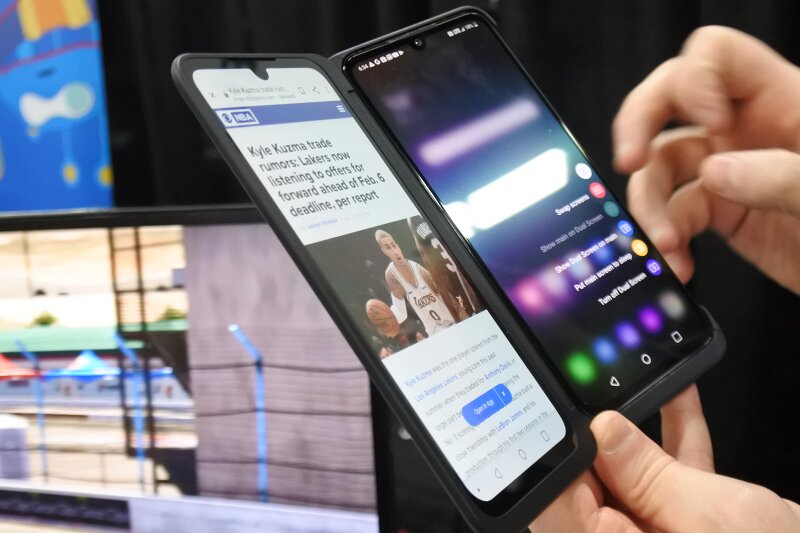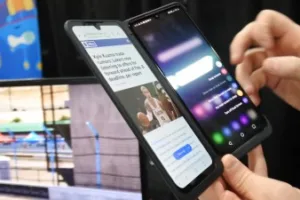The use case for phones with foldable displays remains unconvincing, but that didn’t stop vendors both actual and prospective from showing a growing number of foldable products at CES 2020. Vendors have a powerful motivation to do this and then hope they can drag customers along.

First, there is not much you can do with this year’s smartphone that you can’t do with one made two or three years ago, and sales have plateaued. Manufacturers know they need an excitement injection, but their pursuit of more features and increased performance have raised prices so high that consumers struggle to find a convincing value proposition. What could be more exciting than a foldable display (if you can ignore the stratospheric prices and as-yet unproven technology)?
At CES, LG Electronics presented an interesting alternative with its LG G8X ThinQ folding phone for $699. While the G8X folds, its displays do not. The G8X incorporates twin 6.4-inch, 2340x1080p OLED displays. One is integral with the phone; the other fits into an elastomer case that attaches it to the phone, both mechanically and electrically. If you need maximum battery life and a smaller package, leave the second display at home, in which case battery life is competitive with other premium phones. When the phone and its two displays are folded closed, an external E Ink display provides basic data and call notifications. The phone went on sale in North America in November 2019, and is now available unlocked and for some major carriers.
 1. The out-of-focus menu on the right provides things you can do with the two screens of the LG G8X, including “swap screens’ and “put main screen to sleep.” (Photo: Ken Werner)
1. The out-of-focus menu on the right provides things you can do with the two screens of the LG G8X, including “swap screens’ and “put main screen to sleep.” (Photo: Ken Werner)
Given the striking value proposition, it would make sense to look for the trade-offs. Each of the G8X’s displays have fewer pixels than the single display on Samsung’s premium Galaxy S10+, which has 2960×1440 pixels on its 6.4-inch screen. The single 6.1-inch screen in LG’s own G8 ThinQ has 3120×1440 pixels. (That’s right. The G8 and G8X are very different phones.) But the G8X displays still have a bit over 400 pixels per inch, and the displays support HDR10, so you can watch properly tone-mapped high-dynamic-range movies. The edges of the G8X are tucked into the elastomer case, so there’s no need for a bezel-less look or for flexible displays. I strongly suspect the displays are glass, with that technology’s substantially lower cost.
The other obvious area of cost-saving is that the G8X has “only” two front-facing cameras instead of the three or four that are now almost expected on premium phones. The single “selfie” camera has a generous 32 megapixels. (We can debate whether a 1/2.8″ sensor with 32 million teeny tiny pixels is a good idea some other time.)
Beyond that, the G8X looks like a fully competitive premium camera, with a Qualcomm Snapdragon 855 processor, 128GB of storage, and a 4000mAh battery. The phone has an aluminum frame with Gorilla Glass 6 on the front and Gorilla Glass 5 on the back, and has passed 14 MIL-STD-810G test categories. Security is via an in-screen fingerprint sensor, which suggests the display uses LG Display’s InTouch internal touch technology.
 2. The section of LGE’s booth devoted to the G8X Dual Screen was well attended. The panel in the background shows some of the many ways LGE has thought of to multi-task on two screens. (Photo: Ken Werner)
2. The section of LGE’s booth devoted to the G8X Dual Screen was well attended. The panel in the background shows some of the many ways LGE has thought of to multi-task on two screens. (Photo: Ken Werner)
With makers of folding-display phones asking between $1500 and $2500 dollars, and with current single-display premium phones breaking the $1000 barrier, the value proposition embodied in the G8X ThinQ could look very attractive to customers who want more display real estate, are willing to tolerate a thicker bulge in their hip pockets, but who don’t want to spend their next four car payments on a phone. There was considerable interest in LGE’s booth in Central Hall, but we’ll have to wait and see how many people buy them. (KW)
(We highlighted the use of Keyssa’s wireless technology to join the displays from a data point of view a couple of days ago CES Round-Up Part 2)
Ken Werner is Principal of Nutmeg Consultants, specializing in the display industry, manufacturing, technology, and applications, including mobile devices, automotive, and television. He consults for attorneys, investment analysts, and companies re-positioning themselves within the display industry or using displays in their products. He is the 2017 recipient of the Society for Information Display’s Lewis and Beatrice Winner Award. You can reach him at [email protected] or www.nutmegconsultants.com.

